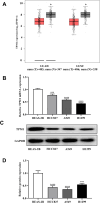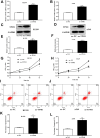Amplified TPM1 suppresses non-small cell lung cancer cells proliferation and metastasis
- PMID: 40515937
- PMCID: PMC12167420
- DOI: 10.1007/s12672-025-02867-8
Amplified TPM1 suppresses non-small cell lung cancer cells proliferation and metastasis
Abstract
Background: TPM1 a member of TPM family and acts as a crucial role in a variety of tumors progression. However, the effect and mechanism of TPM1 on NSCLC need to be further explored. Here, effect and mechanism of TPM1 on NSCLC were revealed to provide new target for clinical therapy.
Methods: TPM1 expression in NSCLC tissues and normal tissues was analyzed using GEPIA online database. NSCLC cells were transfected with TPM1 overexpression plasmid. TPM1 mRNA expression of NSCLC cells was assessed by RT-qPCR. NSCLC cells proliferation and apoptosis were detected by CCK-8 and flow cytometry. Scratch healing and Transwell experiments were introduced to measure NSCLC cells migration and invasion. The effects of TPM1 overexpression on TPM1, YAP1 and EMT related proteins expression in NSCLC cells were detected by Western blot experiments. The interaction between TPM1 and YAP1 was analyzed by the HitPredict database and Co-IP assay.
Results: TPM1 expression in NSCLC was decreased. High expression of TPM1 could inhibit NSCLC cells proliferation, migration and invasion and promote apoptosis. EMT marker E-Cadherin increased in TPM1 overexpression group, while Vimentin and N-Cadherin decreased. EMT process was inhibited by TPM1 overexpression. There is a mutual binding between TPM1 and YAP1, and TPM1 could down-regulate YAP1 expression. Overexpressed YAP1 could partly counteract the inhibition of NSCLC cells proliferation and metastasis induced by TPM1 overexpression.
Conclusion: TPM1 was down-regulated in NSCLC, and its overexpression inhibited NSCLC cells proliferation and metastasis, and this was achieved by regulating YAP1. TPM1 may become a new therapeutic target for NSCLC.
Keywords: Cells proliferation; Metastasis; Non-small cell lung cancer; TPM1; YAP1.
© 2025. The Author(s).
Conflict of interest statement
Declarations. Ethics approval and consent to participate: Not applicable. Consent for publication: Not applicable. Competing interests: The authors declare no competing interests.
Figures






References
-
- Kiyohara C, et al. Genetic polymorphisms and lung cancer susceptibility: a review. Lung Cancer. 2002;37(3):241–56. - PubMed
-
- Li Y, Yan B, He S. Advances and challenges in the treatment of lung cancer. Biomed Pharmacother. 2023;169:115891. - PubMed
-
- Thai AA, et al. Lung cancer. Lancet. 2021;398(10299):535–54. - PubMed
-
- Deshpand R, Chandra M, Rauthan A. Evolving trends in lung cancer: epidemiology, diagnosis, and management. Indian J Cancer. 2022;59(Suppl 1):S90–105. - PubMed
LinkOut - more resources
Full Text Sources
Research Materials
Miscellaneous
